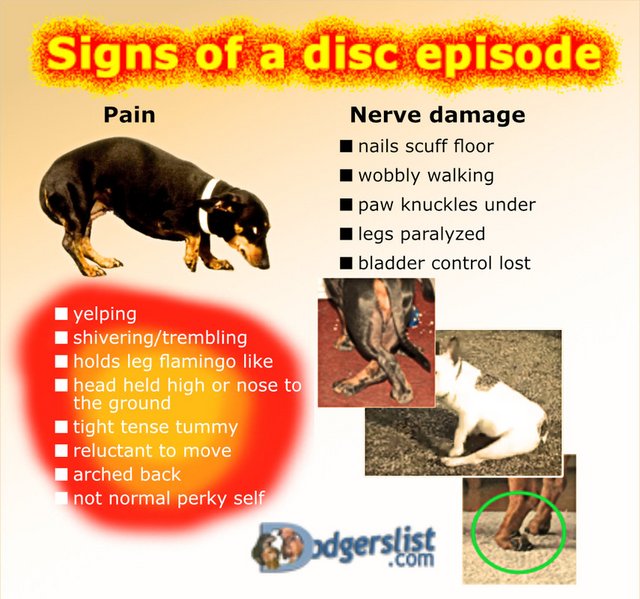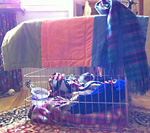Millie, if the treatment with the med prednisone is working to reduce swelling
(at least it looks like it is without the proof positive of stopping the pain med gabapentin), then it is likely the diagnosis of a disc episode was correct. "Shortcut thru IVDD" explains that the typical age when the vet and the owner first know the dog was born with IVDD is 3-7 years old. But not always. For example my one year old doxie had a surgery for a severe disc episode. Please re-review Shortcut thru IVDD here:
dodgerslist.com/2020/06/26/time-and-ivdd/OUR GOAL is to help you get up to speed on IVDD quickly and help you with anything that would be beneficial for your Apricot. You will see links we point you to that come from the Main website:
www.Dodgerslist.com Until you have a chance to browse over there yourself, we want to make sure you read the most important things first by giving you a direct link.
The more you know the better you can care and advocate for your dog.
ADVOCATE
Your dog can't speak up for herself. It is your job to advocate on her behalf the same as you would do for yourself at your doctor's appt.
Avoid a risky to the disc transport for something that can be handled over the phone. Since gabapentin blocks your observations of nerve pain, advocate for a date when you can stop gabapentin.
Let us know what your vet wants. Do you not want proof sooner than later if all swellings actually gone? If there would be painful swelling hidden by gabapentin, it could mean prednisone has not yet done its full job and needs to be back on board up at the original "anti-inflammatory" level. This page is to help you understand the roll prednisone plays with a disc episode:
dodgerslist.com/2020/04/18/steroids-vs-nsaids/Damaged nerves don't hurt. Damaged nerves cause loss of functions (legs, bladder, knuckling.
 **
**
"Normally these calmers are not a problem to help your dog relax in the recovery suite, but always let your vet know of everything your pet is taking." from dodgerslist.com/2020/05/14/strict-rest-recovery-process/
So YES, your vet should know everything you give your dog.
FAMOTIDINE is normally given 2x/day because 12 hrs is how long it is effective for during a disc episode. Learn more about the 3 factors that can cause acid production and why 2x/day:
dodgerslist.com/2020/05/06/stomach-protectionUNWANTED BEHAVIOR
Be aware you might be inadvertently training for unwanted behavior. To dogs rewards are: food, looking at them, talking to them, eye contact, approaching the crate, petting, giving in to what they want.
So anytime you see unwanted behavior
try speaking in your dog's language so she understands to calm down. Turn your body sideways, avoid eye contact until she calms and settles down.
Preferable is to start teaching what you do want before there is too much practice in doing the unwanted behavior. Anytime your dog is sitting or lying down quietly, give a reward of a calm loving "good sit/lie." Soon your dog will see they get rewards by quietly sitting, etc.
The SINGLE most important care you can give is the STRICT inside of the ex-pen recovery suite with door secured closed. Dogs to the unexpected in a blink of an eye. The recovery suite is always flat and supportive of the back. The suite never shifts, cause the dog to unexpectedly change position such as a lap.
The recovery suite is like a cast for a child's broken arm. If a child would plead to have the cast off, would a parent do that? NO way!
When your dog (with mental age of a toddler) complains they don't want to be in the recovery suite, you instead take action to ensure nothing happens to the healing disc. You are an adult who has the ability to read/study and understand what tragedy could happen to the early healing disc with too much movement. Your 2-year old toddler-like Apricot can not think that way.
--- Turn your body sideways, avoid eye contact until she calms and settles down.
--- Drape a blanket over the top of the ex-pen, to be at the level of Apricot's eyes when she is a sit position. If she jumps up, it will be into the darkness of the blanket where she can't see anything. The draped blanket can help to retrain her to not jump against the side of the suite.
 **
**--- Work on letting Apricot know treats are involved when the ex-pen door is closed. Give a command to sit. Give a treat upon the sit thru the wire "door"
-- Then when bringing food to the suite command "sit." If she is not sitting turn your back and wait for a "sit" before proceeding.
--- Any time you see Apricot doing good behavior, praise her: good quiet, good sit, good down, etc. Let her know whenever she is doing something that pleases you.
--- Many members have found a pet stroller to solve issues because the stroller can be wheeled from room to room as you go about your activities. Many dogs love being up high to see all around there home.
Pet strollers, however, should only be used when you are directly supervising. More details on strollers:
dodgerslist.com/2020/05/17/pet-stroller-conservatve-treatment/-- Put a garment you have been wearing and have not washed in the crate.
-- Thundershirt® to calm anxieties similar concept as swaddling an infant to calm.
thundershirt.com/products/thundershirt-for-dogs-- Teaching self-calming exercises can also help your dog to relax more. You can make something as simple as eye contact a very rewarding behavior that also acts as a way for your dog to “ask permission” when she wants something.
When dogs have a focus and an understanding about how to behave to get what they want, they are much calmer overall. To do this, each time your dog looks at you, say, something like, “Yes!” or use a clicker to mark the second he looks at you, and then give your dog a tiny high-value food reward. [NOTE: for crate resting dogs, shift your body a bit] .... wait for your dog to look up at you again, say, “Yes,” and reward again. Do this exercise 10 or so times and then say, “All done,” and put the treats away. Come back later and do it again until you can see that your dog is really starting to make automatic eye contact in hopes you will say, “Yes,” again and give a reward.
[NOTE: treats should be subtracted from the normal daily kibble ration so as not to gain weight during crate rest.
To dogs the size of the treat matters not. ]
wholedogtraining.com/images/stories/Are_all_dogs_trainable.pdf-- Use lo-cal treats to help counteract prednisone's affect on appetite: small pieces of apple or carrot. Frozen green beans. Frozen cube of no-salt, no fat meat broth to lick on in a bowl.
-- Provide a lick mat in the recovery suite. Freeze with some soaked and mushed up kibble, a slight slather of canned dog food or other lo-cal smear, as a very tiny treat but one that will take a lot of time to consume. Use as long as your dog is not exceeding the requirement of little neck/back movement during the recovery rest period
www.amazon.com/s?k=lick+mat+for+dogs&hvadid=78202818358910&hvbmt=be&hvdev=c&hvqmt=e&tag=mh0b-20&ref=pd_sl_3b30nygjvi_e

 **
**
